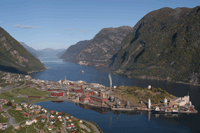Fjord clean up at the Odda smelter
The Sørfjorden fjord adjacent to the Odda zinc smelter, which was once one of the most heavily polluted marine environments in the world, has been returned to almost pre-industrial conditions through a long-term commitment to environmental protection.
 Until the 1970s, the Odda zinc smelter, situated on the shores of the Sørfjorden fjord in western Norway, discharged industrial wastewater into the fjord. At the time, Sørfjorden was one of the most heavily metal-contaminated marine environments in the world. Boliden embarked on a systematic pollution control programme in the late 1970s, in cooperation with the Norwegian authorities.
Until the 1970s, the Odda zinc smelter, situated on the shores of the Sørfjorden fjord in western Norway, discharged industrial wastewater into the fjord. At the time, Sørfjorden was one of the most heavily metal-contaminated marine environments in the world. Boliden embarked on a systematic pollution control programme in the late 1970s, in cooperation with the Norwegian authorities.
Rock cavern waste storage
Rock caverns were built from 1986 to store waste instead of discharging it into the fjord. The caverns were originally constructed to store ferrous process waste (jarosite) from Odda, which contains heavy metals. But the caverns are now also used to store mercury-bearing waste, sulphur-bearing waste and copper matte from Boliden's Bergsöe smelter. The caverns are situated around 1 km from the plant, and are built into solid rock in a mountainside. Boliden has comprehensive safeguards in the caverns to avoid leakage.
The Eitheim Bay Project
The project between 1991 and 1992 contributed towards cleaner fjord water by stabilising the contaminated seabed and reducing polluted groundwater seepage. A canvas was put down on top of the contaminated sediment in the fjord and sand was laid on top to create a new clean seabed. 6 m deep steel barriers were also installed to prevent contaminated groundwater from old landfills seeping into the fjord. Further initiatives between 1995 and 2003 have installed a drainage system that collects and purifies rainwater.
Long-term environmental commitment
Boliden has continuously monitored metal levels in the water since 1979, which represents the longest inlet water monitoring programme in Norway. The levels of zinc, cadmium, lead and mercury have all decreased significantly, and are now well within acceptable limits. Zinc discharge into the fjord, for example, has decreased by a factor of over 600 since 1985, and is now around 75 percent less than the plant's current legal limit.
Fish and mussels in the fjord now contain a negligible level of metals and are considered safe for human consumption, although they are not recommended for pregnant women. Zinc and other metal concentrations in the water have decreased by over 30 times since the late 1980s when concentrations were around 500 micrograms per litre.